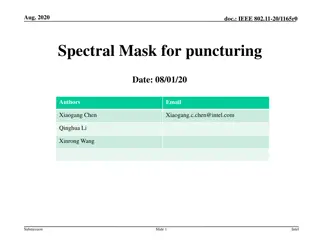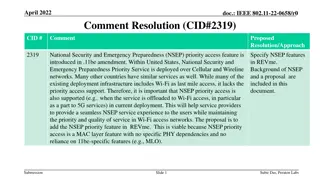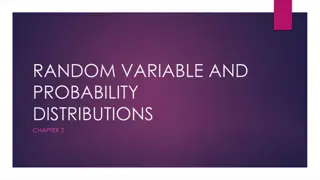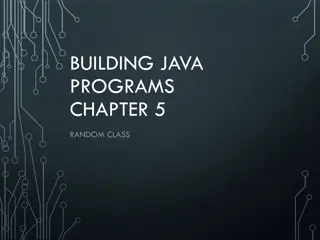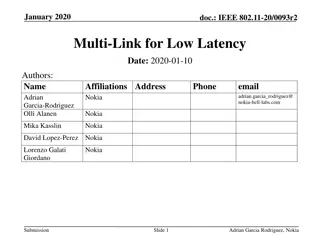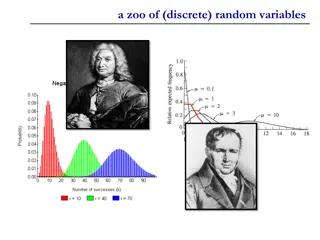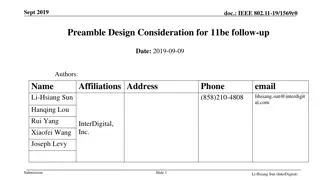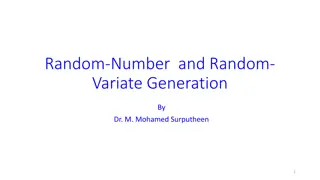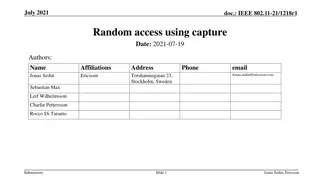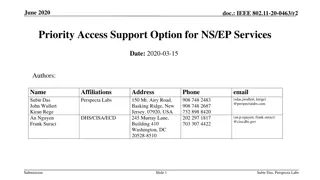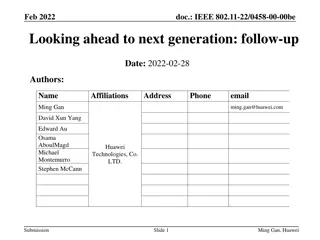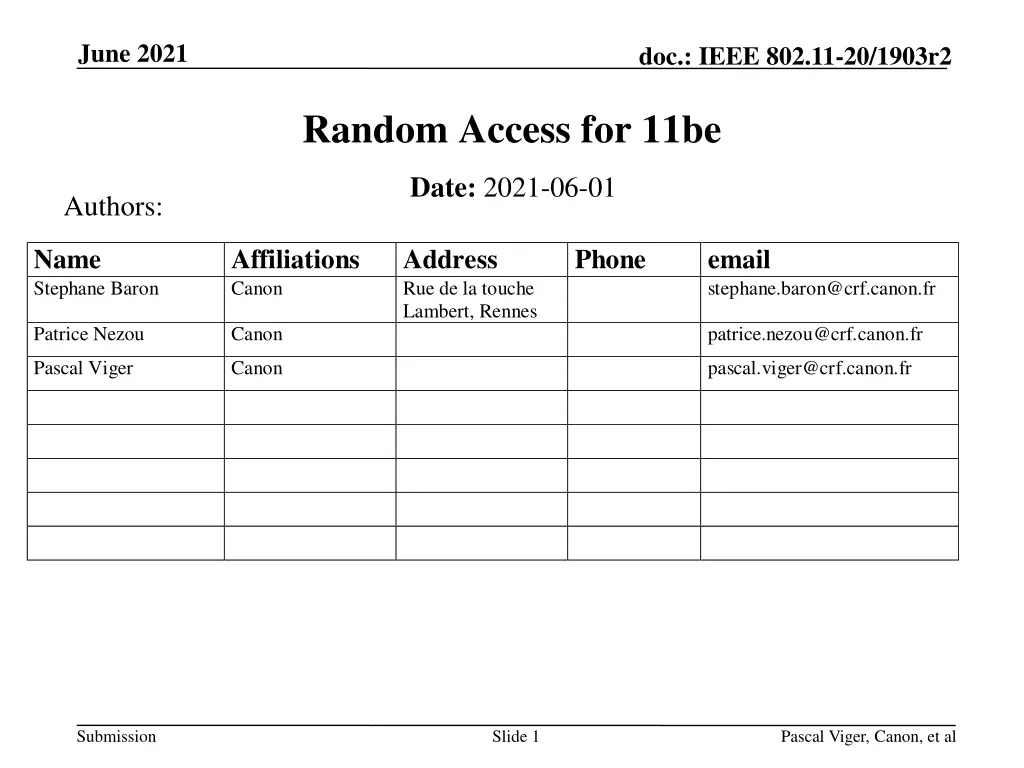
Enhancing Random Access Efficiency for IEEE 802.11be with RA-NFRP Proposal
Explore the innovative Random Access Non-Feedback Request Procedure (RA-NFRP) proposal for IEEE 802.11be, aiming to improve efficiency and scalability. This proposal involves modifications to the existing 802.11ax NFRP design, offering benefits such as greater efficiency and limited MAC changes. Dive into the key points, principles, and illustrations of RA-NFRP to understand its potential impact on random access mechanisms in wireless communication technologies.
Download Presentation

Please find below an Image/Link to download the presentation.
The content on the website is provided AS IS for your information and personal use only. It may not be sold, licensed, or shared on other websites without obtaining consent from the author. If you encounter any issues during the download, it is possible that the publisher has removed the file from their server.
You are allowed to download the files provided on this website for personal or commercial use, subject to the condition that they are used lawfully. All files are the property of their respective owners.
The content on the website is provided AS IS for your information and personal use only. It may not be sold, licensed, or shared on other websites without obtaining consent from the author.
E N D
Presentation Transcript
June 2021 doc.: IEEE 802.11-20/1903r2 Random Access for 11be Date: 2021-06-01 Authors: Name Stephane Baron Affiliations Canon Address Rue de la touche Lambert, Rennes Phone email stephane.baron@crf.canon.fr Patrice Nezou Canon patrice.nezou@crf.canon.fr Pascal Viger Canon pascal.viger@crf.canon.fr Submission Slide 1 Pascal Viger, Canon, et al
June 2021 doc.: IEEE 802.11-20/1903r2 Outline Key Points on Random Access Proposal: Random-Access NFRP (RA-NFRP) for 802.11be RA-NFRP Principle Illustration RA-NFRP Efficiency versus UORA Scalability towards 802.11 technologies or services Annex Legacy 802.11ax UORA procedure Legacy 802.11ax NFRP procedure Details on RA-NFRP (advantages, example format) Submission Slide 2 Pascal Viger, Canon, et al
June 2021 doc.: IEEE 802.11-20/1903r2 Key points UORA provides low efficiency [1]: empty RUs 37%, collision 26%, efficiency 37% lost random RUs (either unused or collided) occur on large transmission durations Random Access still required for 11be ! Many contributions in 11be report that random-access support becomes now difficult but still required : 11-20-831r2, 11-20-1192r1, 11-20-1902r0, 11-21-428r0, 11-21-0400r1 This contribution proposes a Random-Access mechanism based on NFRP: The Triggered PPDU is quite universal, as only energy in RU Tone set Some vendors have already support NFRP: 11-21-0362r1 By offering greater efficiency (74%) Submission Slide 3 Pascal Viger, Canon, et al
June 2021 doc.: IEEE 802.11-20/1903r2 Proposal: Random-Access NFRP (RA-NFRP) RA-NFRP Principle: Reuse the 802.11ax NFRP design, with following modifications : 1. AP provides a NFRP request with Random allocations RA-NFRP TF identified by predefined Starting_AID value (Typically value 0) 2. Random Access to access a RU Tone allocation, by a STA : 1st random phase: STA randomly selects a RU Tone Set Index 2nd random phase: STA randomly selects a Feedback Status (response Y or N) 3. AP then schedules with Basic TF : Schedules a Responding STA by using a sort of temporary AID that corresponds to the RU tone set allocation the STA used By the indexes of RU Tone Sets that correspond to RU Tone Set with a single feedback Easy Collision detection AP considers as correct only a single feedback (responses Y and N means collision, thus no scheduling for such index) Top Benefits Greater efficiency (see next slides), changes limited to MAC. Submission Slide 4 Pascal Viger, Canon, et al
June 2021 doc.: IEEE 802.11-20/1903r2 RA-NFRP Illustration Random access: RA-NFRP identification : startingAID = 0, 2047, Basic TF scheduling: AP schedules STAs using RU Tone Set index - select random RU Tone Set index (e.g. using backoff) - FEEDBACK_STATUS is random AP AP AP A NDP (sent by STA1) 26 tone RU Basic Trigger Frame Data frame (sent by STA1) B Primary 20MHz NFRP Trigger Frame (242 tones) channel (schedule RUs by using RU_TONE _SET_IND EX ) collided C 26 tone RU Multi-STA BA Collided Data frame (sent by at least 2 STAs) (starting AID = 0) NDP (sent by STA20) D NDP (sent by STA2) SIFS SIFS SIFS SIFS Case NDP Feedback detection by AP Comment A correct (single feedback) One single STA transmits a TB NDP Feedback B Not used (no feedback) No further RU scheduled C correct !! (2 STAs use same feedback value) RA-NFRP can not detect the error ! : collided data will not be acknowledged D Error (two feedbacks) 2 tone sets used as Feedback (tones for 0 and 1, so feedback=3) Submission Slide 5 Stephane Baron, Canon, et al
June 2021 doc.: IEEE 802.11-20/1903r2 RA-NFRP Efficiency RA-NFRP is a very efficient RA mechanism, that splits the random access and data communication phases : Detection of Empty NDP RUs will avoid having empty data RUs Early Collision detection (where half of RU_TS collisions are detected thanks to NDP feedback) will reduce waste for further data RUs. Efficiency in Data RU (among 9 Data RUs per 20Mhz) Collision domain (due to random access) Data TX domain (Basic TF) empty 37% (same domains) 3 or 4 UORA collided 26% (same domains) 2 or 3 correct 37% (same domains) 3 or 4 The empty NDP RU Tone Sets are not scheduled for data 37% empty ( 6.66 RU_TS) RA-NFRP + Basic TF 26% / 2 = 13% (2.33 RU_TS) collided 13/(13+37) = 26% 3 or 2 All 9 Data RUs are used 37% correct 37/(13+37) = 74 % 6 or 7 (6.66 RU_TS) Note: UORA uses 9 Data RUs per 20Mhz channel; RA-NFRP uses 18 NDP_RU_TS per 20 MHz channel 26% of Aloha collision, halfed by 2-bit feedback Submission Pascal Viger, Canon, et al Slide 6
June 2021 doc.: IEEE 802.11-20/1903r2 RA-NFRP scalability As only energy is received as NFRP feedback, AP needs to know what kind of station it will address. There is room in User Info field of NFRP format to signal the technologies to schedule/trigger subsequent transmissions: 9 bits in the reserved field (see examples in Annex slide 15) Could be used to signal a given technology Basic 11ax TF, Basic 11be TF, future version, or given service or usage : multi-AP TF Submission Slide 7 Pascal Viger, Canon, et al
June 2021 doc.: IEEE 802.11-20/1903r2 Summary This document presented a Random Access procedure for 11be, on top of NFRP mechanism. Efficiency is close to 74%, extremely greater than the legacy UORA (37%). Scalable to future versions of the 802.11 standard We think 802.11be would largely benefit from such mechanism. Submission Slide 8 Pascal Viger, Canon, et al
June 2021 doc.: IEEE 802.11-20/1903r2 Straw Poll #1 Do you support that 802.11be allows NFRP mechanism to support a Random-Access allocation ? STAs randomly select an RU Tone Set Index and a Feedback Status STAs that win NFRP contention are then scheduled by their RU Tone set Index. Note: This is an R2 feature. Results: Y/N/A Submission Slide 9 Pascal Viger, Canon, et al
June 2021 doc.: IEEE 802.11-20/1903r2 Annex Submission Slide 10 Pascal Viger, Canon, et al
June 2021 doc.: IEEE 802.11-20/1903r2 Recall: UL OFDMA-based Random Access (UORA) UORA allows a non-AP HE STA to access one of a number of resource units designated for random access by the HE AP [1]. UORA provides low efficiency: theoretical probability for random access distributions (Slotted- Aloha type): empty RUs 37%, collision 26%, efficiency 37% lost random RUs (either unused or collided) occur on large transmission durations ! 802.11be needs a more efficient RA mechanism ! Submission Slide 11 Pascal Viger, Canon, et al
June 2021 doc.: IEEE 802.11-20/1903r2 Recall : 802.11ax NFRP procedure NDP Feedback Report Poll (NFRP) TF is used to collect feedback from a range of associated STAs [1]: STAs are identified by a range of AIDs, starting from value of Starting_AID field Scheduled STAs select a tone set according to STA s RU_TONE_SET_INDEX ([1] table 27-32), and modulate tones of the tone set according to the FEEDBACK_STATUS (0/1) to emit. Later, based on received NDP feedbacks, AP may solicit (e.g. via Basic TF for UL MU) some responding STAs e.g. Feedback is 0 Illustration: e.g. Feedback is 1 Submission Slide 12 Pascal Viger, Canon, et al
June 2021 doc.: IEEE 802.11-20/1903r2 NFRP TF format (802.11ax) 340 Submission Slide 13 Pascal Viger, Canon, et al
June 2021 doc.: IEEE 802.11-20/1903r2 RA-NFRP Advantages Fully compliant with legacy 802.11ax format : Keep 11ax design format Starting AID field takes value 0 (optionally 2047 ), any predefined AID value outside the range of AID assigned by AP to associated stations Very efficient random-access mechanism random access is moved to the short time NDP Feedback report procedure AP schedules only used RU Tone Set: no empty data RUs are met in the subsequent UL MU operation Possibly still collisions on UL data RU, but half of the collisions compared to UORA(case C of previous slide) Tips: AP later determines the STA AID (at final stage upon receiving HE TB data PPDU), but this is not an issue. Submission Slide 14 Pascal Viger, Canon, et al
June 2021 doc.: IEEE 802.11-20/1903r2 RA-NFRP TF format TF Techno bitmap This field tells the inquired technology. Value Description B0 B5 B6 B7 B8 0 Resource request 1 Universal request Reserved EHT HE 2-15 Reserved Bits: 6 1 1 1 Keeping conventional Feedback Type (0) or this new value (1) is TBD Submission Slide 15 Pascal Viger, Canon, et al
June 2021 doc.: IEEE 802.11-20/1903r2 Reference [1]. Draft P802.11ax_D8.0 [2]. Submission Slide 16 Pascal Viger, Canon, et al


